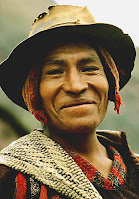- Environment-The Zulu Tribe of Southern Africa live in an area between the Drakensberg and Kalahari borderland where the environment tends to differ. Also called Zululand, the Zulu climate consists of a warm sub-tropical climate for most part of the year. Summer temperatures (November to February) are hot, ranging from 24 to 30 degrees Celsius (about 80 degrees Fahrenheit). The winter temperatures tend to be around a comfortable 20 degrees Celsius (about 70 degrees Fahrenheit). The winter night temperature dips to around 11 degrees Celsius (about 52 degrees Fahrenheit). The rest of the year has very hot days and high humidity levels due to the fact that the Zulu population is subject to sunlight throughout the entire year. The total number of average rainfall days in Zululand in one year is 115 days.


2. Physical Adaptations-Zululand is located just south of the equator, resulting in lots of sunlight reaching this part of the Earth. Due to this abundance of sunlight, the Zulu people's skin have stayed darker over generations of time unlike other groups of people whose skin have lighted over time. The trait to produce more melanin is what produces tan and darker colored skin. This darker colored skin allows for more ultraviolet radiation blockage, which is prominent where the Zulu people live. Although this shielding of light is good, complete blockage of ultraviolet radiation results in negative effects for the Zulu people. A little bit of the radiation needs to be absorbed by the body to keep adequate amounts of Vitamin D. New evidence suggests that vitamin D may help prevent a wide range of cancers, including those of the colon and breasts as well as rickets disease. Since the Zulu people experience high sun exposure, an increase in melanin production helps maintain their homeostasis.
3.Cultural Adaptations-Being that the Zulu culture is subject to year round sunlight, the Zulu have adapted their way of dressing by using clothes that show a lot of skin in order to keep them as cool as possible. They craft their clothes from the natural environment around them. The use of minimal clothing in the warm temperatures allows the Zulu people to remain at a normal, homeostatic body temperature. If they were to wear large furs all year long like some cultures they could risk heat exhaustion or death.
4.Race-If I were to describe the Zulu people by race I would definitely say African. I would say this because they are dark skinned people who live on the continent of Africa. People from Africa tend to have darker skin and fuller lips with a wider nose, which is what these people look like. They also have hair with tight curls which you can see even with the hair being short.
1.
Environment-The Andean Indians live south of Guatemala and the northern coast of South America. The area is largely tropical where the seasons are classified by extreme changes in rainfall and temperature. The lower parts of the Andean environment tend to be hot, while the elevated regions maintain cooler temperatures. Areas of heavy rainfall support dense forest, whereas a few dry regions support little more than sparse grass. Elevation is a key role in the environment where the Andean Indians live.
2.Physical Adaptations-Since the Andean Indians live in highly elevated places, they have developed physical traits that counteract the effect of oxygen deprivation at high altitudes. Common humans began to lose oxygen at an altitude of around one to two miles. Some regions in the Andes are up to three miles high. The Andean Indians have developed a larger lung capacity over thousands of years that give them the advantage to live at such a high altitude. The Andean Indians have a red tinge to the skin because they are making more red blood cells to get the needed amount of oxygen to their tissues. The lungs increase in size to facilitate the osmosis of oxygen and carbon dioxide. There is also an increase in the vascular network of muscles which enhances the transfer of gasses. These adaptations help the Andean people survive in their unique environment.

3. Cultural Adaptations-Since the Andean people live at high altitude in the mountains, most farmland is hard to find because of the slope or the elevated areas. Sporadic periods of rainfall make it even tougher to find the right times to farm. This makes it very difficult to grow adequate food for proper nutrition. To aid these tough conditions the Andean Indians have come up with a system.
They build cisterns and irrigation canals that snake and angle down around the mountains and cut terraces into the hillsides, progressively steeper, from the valleys up the slopes.
4.
Race- The race I would describe the Andean people would be indigenous Central Americans. They have light to medium dark reddish brown skin. Their eye shape is more slanted and they have darker straighter hair. They also have smaller noses that are wider at the bottom.
5.Summary-I personally feel that giving a description of a culture based solely on race gives to many limitations. I feel this way because all groups of people vary in size, height, and color, even certain characteristics such as eye shape and hair texture and be very similar or very different. I feel that giving a description based on the cultures environment and adaptations gives a broader and more in-depth look into a culture and is much more useful within Anthropology. After all there really is not multiple races only the one human race with many different adaptations.
Sources:
Zulu Environment: http://www.zulu.org.za/index.php?districthome+29++57984
Zulu Environment: http://www.zoover.co.uk/south-africa/kwazula-natal/zululand/weather
Zulu Physical Adaptation: http://anthro.palomar.edu/adapt/adapt_4.htm
Zulu Cultural Adaptation: http://www.zulu-culture.co.za/zulu_clothing.php
Zulu Race: http://www.infoplease.com/ce6/society/A0860612.html
Andean Environment: http://www.britannica.com/EBchecked/topic/102247/Central-American-and-northern-Andean-Indian
Andean Physical Adaptation: http://anthro.palomar.edu/adapt/adapt_3.htm
Andean Cultural Adaptation: http://www.des.ucdavis.edu/faculty/orlove/New%20Publications/2002%20American%20Scientist.pdf
Zulu Race: http://www.infoplease.com/ce6/society/A0860612.html











